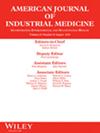Medical Surveillance of Occupational Lead Exposure Using the EPA's Toxics Release Inventory and Adult Blood Lead Epidemiology and Surveillance Program: Illinois, 2016–2023
Abstract
Background
Despite existing regulations mandating exposure control, training, and monitoring, many worksites continue to inadequately protect workers from lead exposure. The Environmental Protection Agency (EPA) requires facilities to report lead emissions to the Toxics Release Inventory (TRI), presenting a potential tool for identifying at-risk worksites. Research has demonstrated that facilities responsible for high levels of environmental pollution often have poor occupational hygiene controls.
Methods
We linked EPA's TRI, the Illinois Adult Blood Lead Registry and business employer data. Using generalized estimating equation (GEE) models, we evaluated the relationship between lead emissions and blood lead testing to estimate the number of potentially exposed workers at sites without medical surveillance of lead exposures between 2016 and 2023.
Results
Of 477 Illinois facilities reporting lead emissions, 8.2% (n = 39) were above-threshold polluters. Only 3.98% (n = 19) reported blood lead testing for 2 or more workers between 2016 and 2023. Average annual on-site emissions were 86 pounds for below-threshold polluters, 2601 pounds for facilities providing medical surveillance, and 16,917 pounds among above-threshold polluters without medical surveillance. Among the 39 above-threshold worksites without medical surveillance, the GEE model estimates that (range low-to-high) 7 to 684 workers annually had positive blood lead levels, and 10 to 256 workers had levels ≥ 25 μg/dL. The models indicate that the majority of estimated exposed workers would be employed at 15 worksites.
Conclusions
Among facilities reporting above-threshold lead releases, workers rarely received blood lead testing. EPA's TRI data can identify facilities where compliance with the OSHA lead standards is inadequate and can help prioritize worksites for outreach.


 求助内容:
求助内容: 应助结果提醒方式:
应助结果提醒方式:


